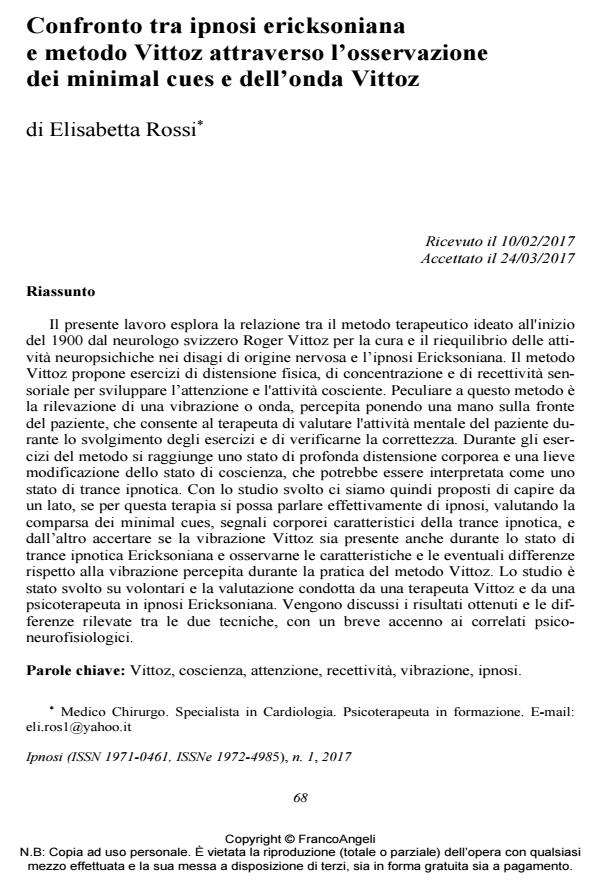Comparing ericksonian hypnosis with Vittoz method through the observation of minimal cues and Vittoz wave
Journal title IPNOSI
Author/s Elisabetta Rossi
Publishing Year 2017 Issue 2017/1
Language Italian Pages 12 P. 68-79 File size 295 KB
DOI 10.3280/IPN2017-001004
DOI is like a bar code for intellectual property: to have more infomation
click here
Below, you can see the article first page
If you want to buy this article in PDF format, you can do it, following the instructions to buy download credits

FrancoAngeli is member of Publishers International Linking Association, Inc (PILA), a not-for-profit association which run the CrossRef service enabling links to and from online scholarly content.
This paper investigates the relations between Ericksonian hypnosis and the therapeutic method that Swiss neurologist Roger Vittoz developed in the early 1900s as a way to rebalance neuropsychological activity in nervous disturbances. The method developed by Vittoz consists in physical relaxation and concentration exercises, as well as in sensory receptivity, in order to develop the patient’s atten-tion and conscious activity. Peculiar to this method is the focus on a mental vibra-tion, or "wave", that the therapist is capable of perceiving by placing his hand on the forehead of the patient. In this way, the therapist is able to evaluate the pa-tient’s mental activity during the therapy and to verify its accuracy. During the ex-ercises, the patient reaches a state of deep body relaxation, accompanied by a slight modification of consciousness, which could be interpreted as a state of hypnotic trance. In this study, we will try to understand if the minimal cues, which, according to Milton Erikson, characterize the normal state of hypnosis, are also present in the trance induced by the Vittoz method. We will later try to evaluate if the mental vibrations, central to the Vittoz method, are also perceivable in trance states induced by Eriksonian hypnosis, and to account for features and potential difference with respect to mental vibrations perceived during trance state induced by the Vittoz method. The study was carried out on volunteers and the evaluation conducted by a therapist Vittoz and a psychotherapist in Ericksonian hypnosis. Ultimately, we will discuss the results obtained and the differences found between the two techniques, with a short indication to the psycho-neurophysiological correlations.
Keywords: Vittoz, consciousness, attention, receptivity, wave, hypnosis.
Elisabetta Rossi, Confronto tra ipnosi ericksoniana e metodo Vittoz attraverso l’osservazione dei minimal cues e dell’onda Vittoz in "IPNOSI" 1/2017, pp 68-79, DOI: 10.3280/IPN2017-001004